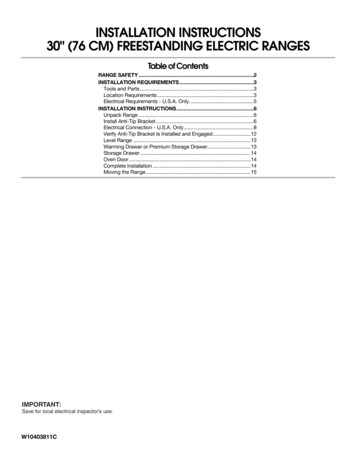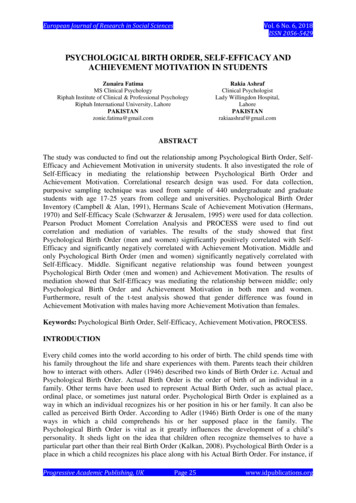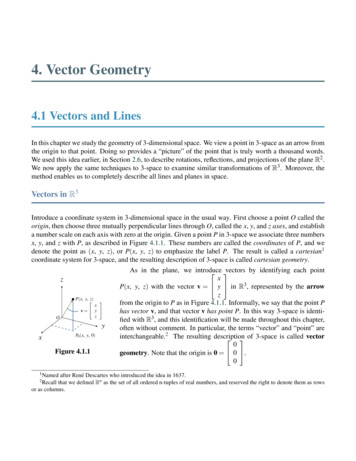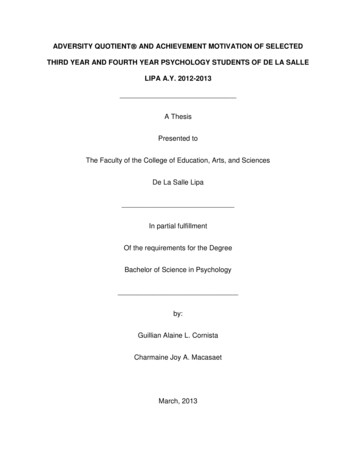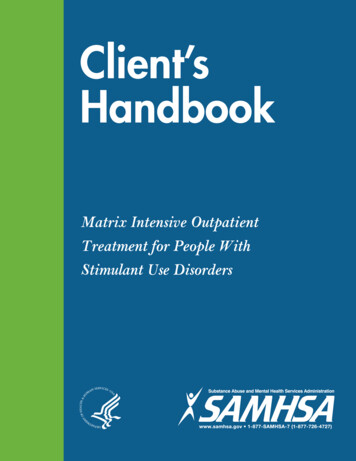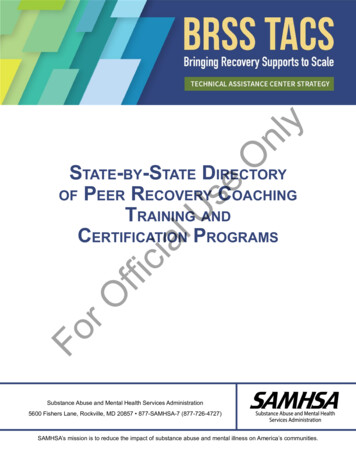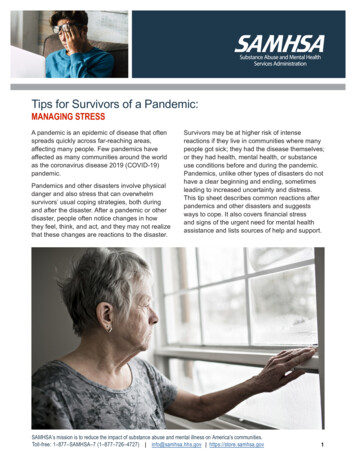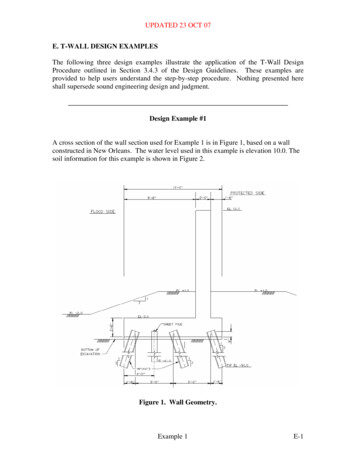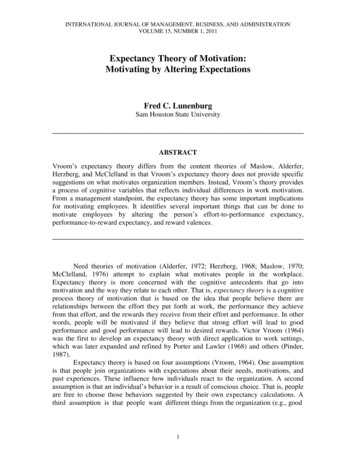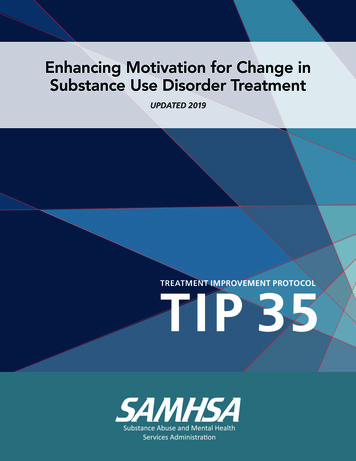
Transcription
Enhancing Motivation for Change inSubstance Use Disorder TreatmentUPDATED 2019TREATMENT IMPROVEMENT PROTOCOLTI P 35
This page intentionally left blank
TIP 35Please share your thoughts about this publication by completing a brief online survey at:www.surveymonkey.com/r/KAPPFSThe survey takes about 7 minutes to complete and is anonymous.Your feedback will help SAMHSA develop future products.iii
This page intentionally left blank
TIP 35ContentsForewordviiiExecutive SummaryixTIP Development ParticipantsxvPublication InformationxxiChapter 1—A New Look at Motivation1461316Motivation and Behavior ChangeChanging Perspectives on Addiction and TreatmentTTM of the SOCConclusionChapter 2—Motivational Counseling and Brief InterventionElements of Efective Motivational Counseling ApproachesMotivational Counseling and the SOCSpecial Applications of Motivational InterventionsBrief Motivational InterventionsScreening, Brief Intervention, and Referral to TreatmentConclusionChapter 3—Motivational Interviewing as a Counseling StyleIntroduction to MIWhat Is New in MIAmbivalenceCore Skills of MI: OARSFour Processes of MIBenefts of MI in Treating SUDsConclusionChapter 4—From Precontemplation to Contemplation: Building ReadinessDevelop Rapport and Build TrustRaise Doubts and Concerns About the Client’s Substance UseUnderstand Special Motivational Counseling Considerations for Clients Mandated toTreatmentConclusionChapter 5—From Contemplation to Preparation: Increasing CommitmentNormalize and Resolve AmbivalenceHelp Tip the Decisional Balance Toward 71778183848793v
TIP 35Enhancing Motivation for Change in Substance Use Disorder TreatmentChapter 6—From Preparation to Action: Initiating ChangeExplore Client Change GoalsDevelop a Change PlanSupport the Client’s Action StepsEvaluate the Change PlanConclusionChapter 7—From Action to Maintenance: Stabilizing ChangeStabilize Client ChangeSupport the Client’s Lifestyle ChangesHelp the Client Reenter the Change er 8—Integrating Motivational Approaches in SUD Treatment Settings 125Adaptations of Motivational Counseling ApproachesWorkforce DevelopmentConclusionvi126131135Appendix A—Bibliography137Appendix B—Screening and Assessment Instruments1 U S Alcohol Use Disorders Identifcation Test (AUDIT)2 Drug Abuse Screening Test (DAST-10)3 Drinker Inventory of Consequences (DrInC) (Lifetime)4 What I Want From Treatment (2 0)5 Readiness to Change Questionnaire (Treatment Version) (RCQ-TV) (Revised)6 Stages of Change Readiness and Treatment Eagerness Scale–Alcohol(SOCRATES 8A)7 Stages of Change Readiness and Treatment Eagerness Scale–Drug (SOCRATES 8D)8 University of Rhode Island Change Assessment (URICA) Scale9 Alcohol and Drug Consequences Questionnaire (ADCQ)10 Alcohol Decisional Balance Scale11 Drug Use Decisional Balance Scale12 Brief Situational Confdence Questionnaire (BSCQ)13 Alcohol Abstinence Self-Efcacy Scale (AASES)14 Motivational Interviewing Knowledge ppendix C—ResourcesMotivational Interviewing and Motivational Enhancement TherapyStages of ChangeTraining and SupervisionSubstance Abuse and Mental Health Services Administration186186186186187
TIP 35ExhibitsExhibit 1 1 Models of AddictionExhibit 1 2 Examples of Natural ChangesExhibit 1 3 The Five Stages in the SOC in the TTMExhibit 2 1 The Drinker’s Pyramid FeedbackExhibit 2 2 Catalysts for ChangeExhibit 2 3 Counselor Focus in the SOCExhibit 2 4 RESPECT: A Mnemonic for Cultural ResponsivenessExhibit 3 1 A Comparison of Original and Updated Versions of MIExhibit 3 2 Misconceptions and Clarifcations About MIExhibit 3 3 Examples of Change Talk and Sustain TalkExhibit 3 4 Closed and Open QuestionsExhibit 3 5 Gordon’s 12 Roadblocks to Active ListeningExhibit 3 6 Types of Refective Listening ResponsesExhibit 3 7 Components in a Sample Agenda MapExhibit 3 8 Examples of Open Questions to Evoke Change Talk Using DARNExhibit 3 9 The Importance RulerExhibit 3 10 The Confdence RulerExhibit 4 1 Counseling Strategies for PrecontemplationExhibit 4 2 Styles of Expression in the Precontemplation Stage: The 5 RsExhibit 4 3 An Opening Dialog With a Client Who Has Been Mandated to TreatmentExhibit 5 1 Counseling Strategies for ContemplationExhibit 5 2 The Motivational Interviewing (MI) Hill of AmbivalenceExhibit 5 3 Decisional Balance Sheet for Substance UseExhibit 5 4 Other Issues in Decisional BalanceExhibit 5 5 Recapitulation SummaryExhibit 6 1 Counseling Strategies for Preparation and ActionExhibit 6 2 When Treatment Goals DiferExhibit 6 3 Change Plan WorksheetExhibit 6 4 Mapping a Path for Change When There Are Multiple OptionsExhibit 7 1 Counseling Strategies for Action and RelapseExhibit 7 2 Options for Responding to a Missed AppointmentExhibit 7 3 Triggers and Coping StrategiesExhibit 7 4 A Menu of Coping StrategiesExhibit 7 5 Susan’s Story: A Client Lacking Social SupportExhibit 7 6 Marlatt’s RPC ProcessExhibit 8 1 Blending the Spirit of MI With 929698101104110114116117119121130vii
TIP 35Enhancing Motivation for Change in Substance Use Disorder TreatmentForewordThe Substance Abuse and Mental Health Services Administration (SAMHSA) is the U.S. Department ofHealth and Human Services agency that leads public health efforts to reduce the impact of substanceabuse and mental illness on America’s communities. An important component of SAMHSA’s work isfocused on dissemination of evidence-based practices and providing training and technical assistance tohealthcare practitioners on implementation of these best practices.The Treatment Improvement Protocol (TIP) series contributes to SAMHSA’s mission by providing sciencebased, best-practice guidance to the behavioral health feld. TIPs refect careful consideration of allrelevant clinical and health service research, demonstrated experience, and implementation requirements.Select nonfederal clinical researchers, service providers, program administrators, and patient advocatescomprising each TIP’s consensus panel discuss these factors, offering input on the TIP’s specifc topics intheir areas of expertise to reach consensus on best practices. Field reviewers then assess draft content andthe TIP is fnalized.The talent, dedication, and hard work that TIP panelists and reviewers bring to this highly participatoryprocess have helped bridge the gap between the promise of research and the needs of practicingclinicians and administrators to serve, in the most scientifcally sound and effective ways, people in need ofcare and treatment of mental and substance use disorders. My sincere thanks to all who have contributedtheir time and expertise to the development of this TIP. It is my hope that clinicians will fnd it useful andinformative to their work.Elinore F. McCance-Katz, M.D., Ph.D.Assistant Secretary for Mental Health and Substance UseU.S. Department of Health and Human ServicesSubstance Abuse and Mental Health Services Administrationviii
TIP 35Executive SummaryMotivation for change is a key component in addressing substance misuse. This Treatment ImprovementProtocol (TIP) refects a fundamental rethinking of the concept of motivation as a dynamic process, not astatic client trait. Motivation relates to the probability that a person will enter into, continue, and adhere toa specifc change strategy.Although much progress has been made in identifying people who misuse substances and who havesubstance use disorders (SUDs) as well as in using science-informed interventions such as motivationalcounseling approaches to treat them, the United States still faces many SUD challenges. For example, theNational Survey on Drug Use and Health (Substance Abuse and Mental Health Services Administration,2018) reports that, in 2017, approximately: 140.6 million Americans ages 12 and older currently consumed alcohol, 66.6 million reportedat least 1 episode of past-month binge drinking (defned as 5 or more drinks on the sameoccasion on at least 1 day in the past 30 days for men and 4 or more drinks on the sameoccasion on at least 1 day in the past 30 days for women), and 16.7 million drank heavily inthe previous month (defned as binge drinking on 5 or more days in the past 30 days).30.5 million people ages 12 and older had used illicit drugs in the past month.11.4 million people ages 12 and older misused opioids (defned as prescription pain relievermisuse or heroin use) in the past year.8.5 million adults ages 18 and older (3.4 percent of all adults) had both a mental disorder andat least 1 past-year SUD.18.2 million people who needed SUD treatment did not receive specialty treatment.One in three people who perceived a need for substance use treatment did not receive itbecause they lacked healthcare coverage and could not afford treatment.Two in fve people who perceived a need for addiction treatment did not receive it becausethey were not ready to stop using substances.Millions of people in the United States with SUDs are not receiving treatment. Many are not seekingtreatment because their motivation to change their substance use behaviors is low.The motivation-enhancing approaches and strategiesthis TIP describes can increase participation andretention in SUD treatment and positive treatmentoutcomes, including: Reductions in alcohol and drug use.Higher abstinence rates.Successful referrals to treatment.This TIP shows how SUD treatment counselors can infuence positive behavior change by developinga therapeutic relationship that respects and builds on the client’s autonomy. Through motivationalenhancement, counselors become partners in the client’s change process.The TIP also describes different motivational interventions counselors can apply to all the stages in theStages of Change (SOC) model related to substance misuse and recovery from addiction.A consensus panel developed this TIP’s content based on a review of the literature and on panel members’extensive experience in the feld of addiction treatment. Other professionals also generously contributedtheir time and commitment to this project.ix
TIP 35Enhancing Motivation for Change in Substance Use Disorder TreatmentIntended AudienceThe primary audiences for this TIP are: Drug and alcohol treatment service providers.Mental health service providers, such aspsychologists, licensed clinical social workers,and psychiatric/mental health nurses.Peer recovery support specialists.Behavioral health program managers, directors,and administrators.Clinical supervisors.Healthcare providers, such as primary carephysicians, nurse practitioners, general/familymedicine practitioners, registered nurses,internal medicine specialists, and others whomay need to enhance motivation to addresssubstance misuse in their patients.Secondary audiences include preventionspecialists, educators, and policymakers for SUDtreatment and related services.Overall Key MessagesMotivation is key to substance use behaviorchange. Counselors can support clients’ movementtoward positive changes in their substance useby identifying and enhancing motivation thatalready exists.Motivational approaches are based on theprinciples of person-centered counseling.Counselors’ use of empathy, not authority andpower, is key to enhancing clients’ motivation tochange. Clients are experts in their own recoveryfrom SUDs. Counselors should engage them incollaborative partnerships.Ambivalence about change is normal.Resistance to change is an expression ofambivalence about change, not a client traitor characteristic. Confrontational approachesincrease client resistance and discord in thecounseling relationship. Motivational approachesexplore ambivalence in a nonjudgmental andcompassionate way.The Transtheoretical Model (TTM) of the SOCapproach is an overarching framework that helpsxcounselors tailor specifc counseling strategiesto different stages. Motivational counselingstrategies should be tailored to clients’ level ofmotivation to change their substance use behaviorsat each of the fve stages of the SOC: tenanceEffective motivational counseling approachescan be brief. A growing body of evidenceindicates that early and brief interventionsdemonstrate positive treatment outcomes in awide variety of settings including specialty SUDtreatment programs, primary care offces, andemergency departments. Brief interventionsemphasize reducing the health-related riskof a person’s substance use and decreasingconsumption as an important treatment outcome.Motivational interviewing (MI) and othermotivational counseling approaches likemotivational enhancement therapy are effectiveways to enhance motivation throughout theSOC. Motivational counseling approaches arebased on person-centered counseling principlesthat focus on helping clients resolve ambivalenceabout changing their substance use and otherhealth-risk behaviors.MI is the most widely researched anddisseminated motivational counselingapproach in SUD treatment. The spirit of MI(i.e., partnership, acceptance, compassion,and evocation) is the foundation of the corecounseling skills required for enhancing clients’motivation to change. The core counseling skillsof MI are described in the acronym OARS (Openquestions, Affrmations, Refective listening,and Summarization).Counselor empathy, as expressed throughrefective listening, is fundamental to MI. Useof empathy, rather than power and authoritativeapproaches, is critical for helping clients achieveand maintain lasting behavior change.
TIP 35Adaptations of MI enhance the implementationand integration of motivational interventionsinto standard treatment methods. Training,ongoing supervision, and coaching of counselorsare essential for workforce development andintegration of motivational counseling approachesinto SUD treatment. Content OverviewChapter 1—A New Look at MotivationThis chapter lays the groundwork forunderstanding treatment concepts discussedlater in the TIP. It is an overview of the nature ofmotivation and its link to changing substanceuse behaviors. The chapter describes changingperspectives on addiction and addiction treatmentin the United States and uses the TTM of theSOC approach as an overarching framework tounderstand how people change their substanceuse behaviors.In Chapter 1, readers will learn that: Motivation is essential to substance usebehavior change. It is multidimensional,dynamic, and fuctuating; can be enhanced; andis infuenced by the counselor’s style.Benefts of using motivational counselingapproaches include clients’ enhancingmotivation to change, preparing them to entertreatment, engaging and retaining clients intreatment, increasing their participation andinvolvement in treatment, improving theirtreatment outcomes, and encouraging a rapidreturn to treatment if they start misusingsubstances again.New perspectives on addiction treatmentinclude focusing on clients’ strengthsinstead of defcits, offering person-centeredtreatment, shifting away from labeling clients,using empathy, focusing on early and briefinterventions, recognizing that there is a rangeof severity of substance misuse, accepting riskreduction as a legitimate treatment goal, andproviding access to integrated care.People go through stages in the SOC approach;this concept is known as the TTM of change.The stages in the SOC model are:- Precontemplation, in which people are notconsidering change.- Contemplation, in which people areconsidering change but are unsure howto change.- Preparation, in which people have identifeda change goal and are forming a planto change.- Action, in which people are taking stepsto change.- Maintenance, in which people have mettheir change goal and the behavior changeis stable.Chapter 2—Motivational Counseling andBrief InterventionThis chapter is an overview of motivationalcounseling approaches, including screening, briefintervention, and referral to treatment (SBIRT).It describes elements of effective motivationalcounseling approaches, including FRAMES(Feedback, Responsibility, Advice, Menu ofoptions, Empathy, and Self-effcacy), decisionalbalancing, discrepancy development, fexiblepacing, and maintenance of contact with clients.The chapter describes counselors’ focus in eachstage of the SOC model. It addresses specialapplications of motivational counseling withclients from diverse cultures and with clients whohave co-occurring substance use and mentaldisorders (CODs).In Chapter 2, readers will learn that: Each stage in the SOC approach haspredominant experiential and behavioralcatalysts for client change on which counselorsshould focus.Counselors should adopt the principles ofcultural responsiveness and adapt motivationalinterventions to those principles when treatingclients from diverse backgrounds.Even mild substance misuse can impedefunctioning in people with CODs, includingco-occurring severe mental illness. Counselorscan adapt motivational interventions forthese clients.xi
TIP 35 Enhancing Motivation for Change in Substance Use Disorder TreatmentBrief motivational interventions, including SBIRT,are effective in specialty SUD treatment facilitiesand opportunistic settings (e.g., primary careoffces, emergency departments).Brief interventions emphasize risk reductionand referral to specialty addiction treatmentif needed.Chapter 3—Motivational Interviewing asa Counseling StyleThis chapter provides an overview of the spirit ofMI, the principles of person-centered counseling,the core counseling skills of MI (i.e. asking openquestions, affrming, refective listening, andsummarizing), and the four processes of MI (i.e.,engaging, focusing, evoking, and planning). Itdescribes what’s new in MI and dispels manymisconceptions about MI. The chapter discussesthe components that counselors use to help clientsresolve ambivalence and move toward positivesubstance use behavior change.In Chapter 3, readers will learn that: Ambivalence about substance use and change isnormal and a motivational barrier to substanceuse behavior change, if not explored.The spirit of MI embodies the principles ofperson-centered counseling and is the basis ofan empathetic, supportive counseling style.Sustain talk is essentially statements the clientmakes for not changing (i.e., maintaining thestatus quo), and change talk is statementsthe client makes in favor of change. The keyto helping the client move in the directiontoward changing substance use behaviorsis to evoke change talk and soften or lessenthe impact of sustain talk on the client’sdecision-making process.The acronym OARS describes the core skillsof MI:- Asking Open questions- Affrming the client’s strengths- Using Refective listening- Summarizing client statementsRefective listening is fundamental to personcentered counseling in general and MI inparticular and is essential for expressingempathy.xii The four processes in MI (i.e., engaging,focusing, evoking, and planning) provide anoverarching framework for employing the coreskills in conversations with a client.The benefts of MI include its broad applicabilityto diverse medical and behavioral healthproblems and its capacity to complementother counseling approaches and to mobilizeclient resources.Chapter 4—From Precontemplation toContemplation: Building ReadinessThis chapter discusses strategies counselorscan use to help clients raise doubt and concernabout their substance use and move towardcontemplating the possibility of change. Itemphasizes the importance of assessing clients’readiness to change, providing personalizedfeedback to them about the effects and risksof substance misuse, involving their signifcantothers in counseling to raise concern aboutclients’ substance use behaviors, and addressingspecial considerations for treating clients who aremandated to treatment.In Chapter 4, readers will learn that: A client in the Precontemplation stage isunconcerned about substance use or is notconsidering change.The counselor’s focus in Precontemplation isto establish a strong counseling alliance andraise the client’s doubts and concerns aboutsubstance use.Key strategies in this stage include eliciting theclient’s perception of the problem, exploringthe events that led to entering treatment, andidentifying the client’s style of Precontemplation.Providing personalized feedback on assessmentresults and involving signifcant others incounseling sessions are key strategies forraising concern and moving the client towardcontemplating change.Special considerations in motivationalcounseling approaches for clients mandatedto treatment include acknowledging clientambivalence and emphasizing personal choiceand responsibility.
TIP 35Chapter 5—From Contemplation toPreparation: Increasing CommitmentThis chapter describes strategies to increaseclients’ commitment to change by normalizingand resolving ambivalence and enhancing theirdecision-making capabilities. It emphasizesdecisional balancing and exploring clients’ selfeffcacy as important to moving clients towardpreparing to change substance use behaviors.Summarizing change talk and exploring theclient’s understanding of change prepare clients totake action. In Chapter 5, readers will learn that: In the Contemplation stage, the clientacknowledges concerns about substance useand is considering the possibility of change.The counselor’s focus in Contemplation is tonormalize and resolve client ambivalence andhelp the client tip the decisional balance towardchanging substance use behaviors.Key motivational counseling strategies forresolving ambivalence include reassuring theclient that ambivalence about change is normal;evoking DARN (Desire, Ability, Reasons, andNeed) change talk; and summarizing theclient’s concerns.To reinforce movement toward change, thecounselor reinforces the client’s understandingof the change process, reintroducespersonalized feedback, explores client selfeffcacy, and summarizes client change talk.The counselor encourages the client tostrengthen his or her commitment to change bytaking small steps, going public, and envisioninglife after changing substance use behaviors.Chapter 6—From Preparation to Action:Initiating ChangeThis chapter describes the process of helpingclients identify and clarify change goals. It alsofocuses on how and when to develop changeplans with clients and suggests ways to ensure thatplans are accessible, acceptable, and appropriatefor clients.In Chapter 6, readers will learn that: In the Preparation stage, the client is committedand planning to make a change but is unsure ofwhat to do next. In the Action stage, the clientis actively taking steps to change but has notreached stable recovery.In Preparation, the counselor focuses on helpingthe client explore change goals and develop achange plan. In Action, the counselor focuses onsupporting client action steps and helping theclient evaluate what is working and not workingin the change plan.The client who is committed to change and whobelieves change is possible is prepared for theAction stage.Sobriety sampling, tapering down, and trialmoderation are goal-sampling strategiesthat may be helpful to the client who is notcommitted to abstinence as a change goal.Creating a change plan is an interactive processbetween the counselor and client. The clientshould determine and drive change goals.Identifying and helping the client reducebarriers to the Action stage are important to thechange-planning process.Counselors can support client action byreinforcing client commitment and continuingto evoke and refect CAT (i.e., Commitment,Activation, and Taking steps) change talk inongoing conversations.Chapter 7—From Action to Maintenance:Stabilizing ChangeThis chapter addresses ways in which motivationalstrategies can be used effectively to help clientsmaintain the gains they have made by stabilizingchange, supporting lifestyle changes, managingsetbacks during the Maintenance stage, andhelping them reenter the cycle of change ifthey relapse or return to substance misuse. Itemphasizes creating a coping plan to reduce therisk of recurrence in high-risk situations, identifyingnew behaviors that reinforce change, andestablishing relapse prevention strategies.In Chapter 7, readers will learn that: During the Maintenance stage, the client hasachieved the initial change goals and is workingtoward maintaining those changes.xiii
TIP 35 Enhancing Motivation for Change in Substance Use Disorder TreatmentIn Maintenance, the counselor focuses onhelping the client stabilize change and supportsthe client’s lifestyle changes.During a relapse, the client returns tosubstance misuse and temporarily exitsthe change cycle. The counselor focuseson helping the client reenter the cycle ofchange and providing relapse preventioncounseling in accordance with the principles ofperson-centered counseling.Maintenance of substance use behavior changein the SOC model must address the issue ofrelapse. Relapse should be reconceptualizedas a return to or recurrence of substance usebehaviors and viewed as a common occurrence.Relapse prevention counseling is a cognitive–behavioral therapy (CBT) method, but thecounselor can use motivational counselingstrategies to engage the client in the processand help the client resolve ambivalence aboutlearning and practicing new coping skills.Strategies to help a client reenter the changecycle after a recurrence include affrmingthe client’s willingness to reconsider positivechange, exploring reoccurrence as a learningopportunity, helping the client fnd alternativecoping strategies, and maintaining supportivecontact with the client.Chapter 8—Integrating MotivationalApproaches in SUD Treatment SettingsThis chapter discusses some of the adaptationsof motivational counseling approaches applicableto SUD treatment programs and workforcedevelopment issues that treatment programsshould address to fully integrate and sustainmotivational counseling approaches. It emphasizesblending MI with other counseling approaches.It also explores ways in which ongoing training,supervision, and coaching are essential tosuccessful workforce development and integration.In Chapter 8, readers will learn that: Integrating motivational counseling approachesinto a treatment program requires a broadintegration of the philosophy and underlyingspirit of MI throughout the organization.xiv Adapted motivational interventions may bemore cost effective, accessible to clients,and easily integrated into existing treatmentapproaches than expected and may ease someworkload demands on counselors.Technology adaptations, including motivationalcounseling and brief interventions over thephone or via text messaging, are effective,cost effective, and adaptable to differentclient populations.MI is effective when blended withother counseling approaches includinggroup counseling, the motivationalinterviewing assessment, CBT, and recoverymanagement checkups.The key to workforce development is to trainall clinical and support staffs in the spirit ofMI so that the entire program’s philosophy isaligned with person-centered principles, likeemphasizing client autonomy and choice.Program administrators should assess theorganization’s philosophy and where it isin the SOC model before implementing atraining program.Training counseling staff in MI takes more thana 1- or 2-day workshop. Maintenance of skillsrequires ongoing training and supervision.Supervision and coaching in MI should becompetency based. These activities requiredirectly observing the counselor’s skill level andusing coding instruments to assess counselorfdelity. Supervision should be performed in thespirit of MI.Administrators need to balance training,supervision, and strategies to enhancecounselor fdelity to MI with costs, whilepartnering with counseling staff to integrate amotivational counseling approach throughoutthe organization.
TIP 35TIP Development ParticipantsConsensus PanelEach Treatment Improvement Protocol’s (TIP)consensus panel is a group of primarily nonfederaladdiction-focused clinical, research, administrative,and recovery support experts with deepknowledge of the TIP’s topic. With the SubstanceAbuse and Mental Health Services Administration’sKnowledge Application Program team, membersof the consensus panel develop each TIP via aconsensus-driven, collaborative process that blendsevidence-based, best, and promising practiceswith the panel members’ expertise and combinedwealth of experience.ChairWilliam R. Miller, Ph.D.Regents Professor of Psychology and PsychiatryDirector of ResearchCenter on Alcoholism, Substance Abuse, andAddictionsDepartment of PsychologyUniversity of New MexicoAlbuquerque, New MexicoWorkgroup LeadersEdward Bernstein, M.D., F.A.C.E.P.Associate Professor and Academic AffairsVice ChairmanBoston University School of MedicineBoston, MassachusettsSuzanne M. Colby, Ph.D.Assistant Professor of Psychiatry and HumanBehaviorCenter for Alcohol and Addiction StudiesBrown UniversityProvidence, Rhode IslandCarlo C. DiClemente, Ph.D.Department of PsychologyUniversity of Maryland, Baltimore CountyBaltimore, MarylandRobert J. Meyers, M.A.Center on Alcoholism, Substance Abuse, andAddictionsUniversity of New MexicoAlbuquerque, New MexicoMaxine L. Stitzer, Ph.D.Professor of Psychiatry and Behavioral BiologyJohns Hopkins University School of MedicineBaltimore, MarylandAllen Zweben, D.S.W.Director and Associate Professor of Social WorkCenter for Addiction and Behavioral HealthResearchUniversity of Wisconsin at MilwaukeeMilwaukee, WisconsinPanelistsRay DawExecutive DirectorNorthwest New Mexico Fighting Back, Inc.Gallup, New MexicoJeffrey M. Georgi, M.Div., C.S.A.C., C.G.P.Program CoordinatorDuke Alcoholism and Addictions ProgramClinical AssociateDepartment of Psychiatry and Behavioral ScienceDuke University Medical CenterDurham, North CarolinaCheryl Grills, Ph.D.Department of PsychologyLoyola Marymou
TIP 35 Enhancing Motivation for Change in Substance Use Disorder Treatment Chapter 6—From Preparation to Action: Initiating Change 95 Explore Client Change Goals 96 Develop a Change Plan 99 Support t
